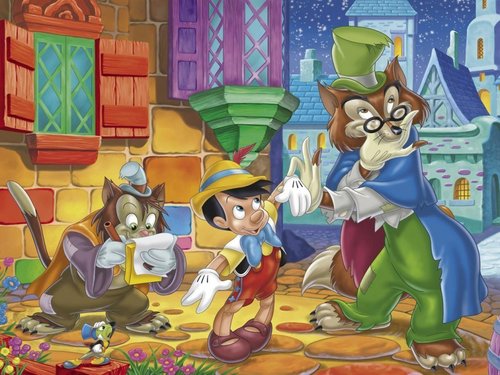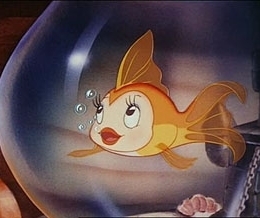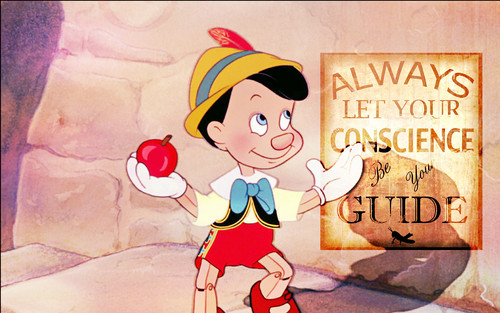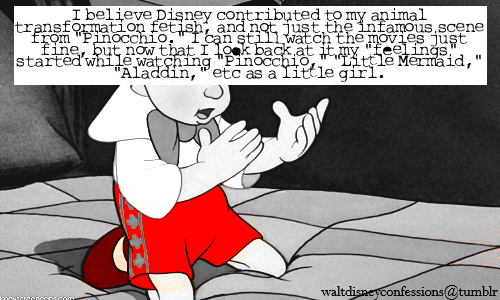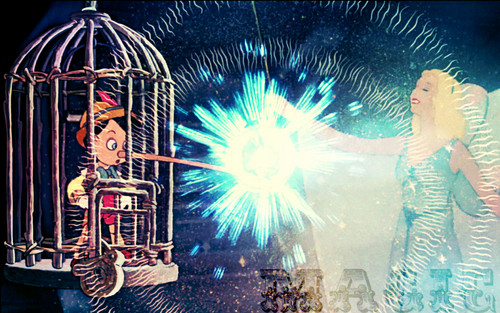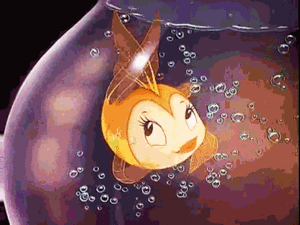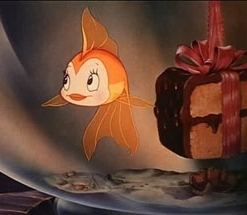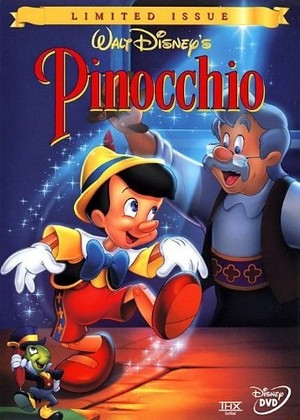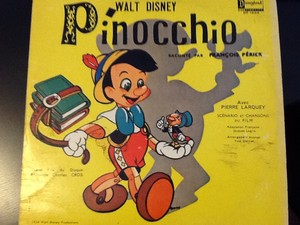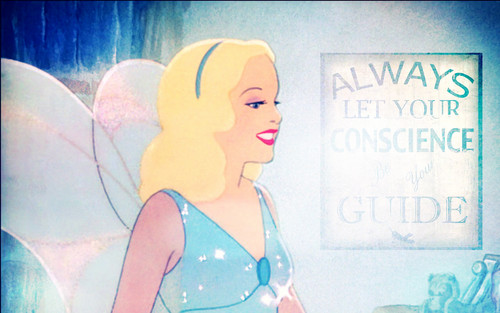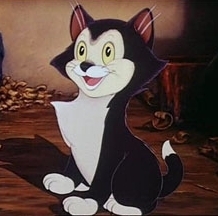A 디즈니 Tale: A poor woodcutter, Geppetto, wishes on a 별, 스타 that his wooden puppet boy could be alive. A blue fairy grants his wish and the puppet, Pinocchio, is given life. On a series of adventures, he learns about right and wrong on his journey to becoming a real, human boy.
디즈니 Heroine: There is no real 'heroine' in this story and in fact, the only female characters are the Blue Fairy and Cleo the fish.
디즈니 Hero: Pinocchio is the 'hero' of the story, in as much as he is the main character. His heroic actions, though, don't really occur until the final act of the film where is saves Geppetto from the belly of Monstro the Whale. He is an interesting character. Gullible to a fault, naive and innocent, he only narrowly escapes various terrible fates through the efforts of Jiminy Cricket and the Blue Fairy. Were it not for them he would either be Stromboli's captive 또는 transformed into a donkey and working in a salt mine. He is, though, much 더 많이 endearing than Snow White as a main character. He is like the naughty child 당신 can't help but have a soft spot for, particularly as the audience knows its the evil adult characters who are responsible for him being lead astray and not through any deliberate intentions on his own part. It is interesting to read that, originally, the animators tried to make Pinocchio far 더 많이 like a puppet than a boy and that 디즈니 wasn't happy about the depiction. Only when a different artist made him 더 많이 child-like was he happy and I have to agree that it seems pivotal to the audience empathising with Pinocchio to have him look as he does.
디즈니 Villain: Pinocchio is positively packed with villains. Initially we have Honest John and Gideon, two con artists who lead Pinocchio to Stromboli, the 다음 villain. Honest John and Gideon are unusual. They are the only non-human characters (not counting the non-speaking roles of Figaro the Cat and Cleo the Goldfish) in the whole film, being an anthropomorphised 여우 and cat. Quite why this is, is never explained and they do seem out of place in a film otherwise populated 의해 humans (or humanoid, in the case of the Blue Fairy). Also, they are not truly evil. They are conmen, out for a quick buck where they can get it. From their clothes, they seem to lead a vagrant lifestyle although seem based in Pinocchio's village; Honest John 코멘트 that Stromboli is back in town.
Stromboli is a villain closer, in looks, to the archetypal 'evil' antagonist familiar from 디즈니 films. Large, imposing with a black beard and vicious eyes, he fulfills the role well. But even then, he features only briefly in the first part of the film and after Pinocchio escapes from him with the help of the Blue Fairy, he is never seen again. Also, I'm not entirely sure how villainous he truly is. He runs a puppet show and is presented with a live puppet. Obviously he wants to keep Pinocchio for his show - a guaranteed money-spinner, but we aren't given any other reasons for finding him villanous other than keeping Pinocchio captive against his will. It isn't suggested that he has done this before (when would that have happened anyway) and he seems to be a fairly ordinary travelling show man, albeit with a slightly scary exterior.
The 다음 villain of the piece, the Coachman, is the only truly villainous piece. He has a scheme involving the luring and kidnapping of young boys to be taken to Pleasure Island where, after indulging in various unhealthy excesses, are turned into donkeys and shipped off to work as slaves. He is truly evil. One scene sees his face transform momentarily into a demonic visage. Honest John and Gideon are again responsible for dropping Pinocchio into his clutches but then they disappear from the film, presumably with their paultry cut. The Coachman, meanwhile, transports the boys to Pleasure Island and uses black, shadowy figures to shut them in and then trap and transport the transformed boys. He is a nightmarish creation: one part Childcatcher (from Chitty Chitty Bang Bang); one part Mr Pickwick. But again, he disappears from the story once Pinocchio escapes.
The final villain is Monstro, the Whale. Although his initial swallowing of Geppet,to seems coincidental, when Pinocchio helps his father escape 의해 lighting a 불, 화재 inside Monstro's belly, the 고래 goes on the rampage, determined to catch and kill Geppetto and Pinocchio. Monstro is large and vicious and provides a suitably dramatic climax to the film.
디즈니 Sidekicks: Jiminy Cricket is the principal sidekick and was, apparently, a relatively late addition to the story. He acts as Pinocchio's conscience, although his efforts are fairly fruitless to begin with. Like Honest John and Gideon, he begins the story as a vagrant slipping into Geppetto's 집 for a warm 불, 화재 and a place to rest his head. There are some fun scenes with him interacting with some of Geppetto's wooden toys. He is a fun character and reminds me a little of Mushu from Mulan. In a modern 디즈니 film, 당신 can imagine he would probably be far 더 많이 wise-cracking than he is here, although he does have his fair share of pithy comments.
디즈니 Creatures: Figaro and Cleo are the cute 동물 of Pinocchio. As 더 많이 defined characters than the generic woodland 동물 of Snow White, they have 더 많이 impact on the audience and my particular favourite of the two is the saucy Cleo - a goldfish with
a line of huge lips and coy expressions, hiding her face behind her fantail. Figaro is a cheeky kitten, grumpy when made to wait for food, of forced to get out of 침대 to open windows for Geppetto. He is, to some degree, Geppetto's first child, displaced a little 의해 the arrival of Pinocchio.
디즈니 Magic: The Blue Fairy is Disney's first 'magical' protagonist. Later films would see characters such as the Fairy Godmother in 신데렐라 and Flora, Fauna and Merryweather in Sleeping Beauty. They are maternal, almost frumpy characters, as comedic as they are magical. The Blue Fairy is graceful, beautiful and demure. She drifts in, grants wishes and drifts away. At one point, she takes the form of a dove. The maternal nature is still present though, particularly in the way she causes Pinocchio's nose to grow when he tells a lie. The nose-growing is something which 인기 culture immediately associates with Pinocchio and even translated into Shrek's version of the character, often as the punchline to gags. In the 디즈니 version, though, it features far less prominently than I had thought, really only being significant in the scene where the Blue Fairy releases Pinocchio from Stromboli's cage.
디즈니 Land: The location of the story is suitably vague. The clothes and buildings are clearly European and put me in mind of Germany 또는 Austria. The wikipedia entry suggests it is a village in Tuscany and this would ring true to the original story's Italian origins, but I can't see it myself. The most striking location of the story though is Pleasure Island. A nightmarish world of drinks and drugs, it is presented in a horrific way - it's like when clowns are made to look creepy. For a children's animated film it is dark and sinister and sets the scene for some of the film's most terrifying scenes: Lampwick's transformation into a donkey and the 'left unsaid' fate of the talking donkeys. Chilling.
디즈니 Songs: The songs in Pinocchio are far 더 많이 catchy and interesting than those in Snow White. The theme song of 'When 당신 Wish Upon a Star' is legendary but I had forgotten that Jiminy is actually 노래 it during the opening of the film, remembering it 더 많이 of a 'backing track' as it were. My favourite song is probably 'I've Got No Strings' which is a fun song with the different verses involving the puppets from Stromboli's theatre (I misremembered these as being 더 많이 'alive' than they are but it is never revealed who is providing the female voices for them); but An Actor's Life for Me comes a close 초 as we get our first 'villain's song'. There is also the catchy 'Give a Little Whistle' providing the first sidekick song.
디즈니 Finale: If we take Snow White and Pinocchio together, we have the makings of a 디즈니 archetype. Whilst Snow White has the prince and princess 사랑 story; a powerful antagonist and the fairy tale basis; Pinocchio has the hero who learns something, the villain and sidekick songs, the balance between comedy and horror and the magical protector. These are elements which will recur throughout the 디즈니 canon, right up until the most recent entries. Pinocchio is a far 더 많이 entertaining film than Snow White, has a 더 많이 appealing central character and were it not for the rather fractured approach to storytelling (the story is really just a series of set pieces involving Pinocchio), would be a great story.
디즈니 Heroine: There is no real 'heroine' in this story and in fact, the only female characters are the Blue Fairy and Cleo the fish.
디즈니 Hero: Pinocchio is the 'hero' of the story, in as much as he is the main character. His heroic actions, though, don't really occur until the final act of the film where is saves Geppetto from the belly of Monstro the Whale. He is an interesting character. Gullible to a fault, naive and innocent, he only narrowly escapes various terrible fates through the efforts of Jiminy Cricket and the Blue Fairy. Were it not for them he would either be Stromboli's captive 또는 transformed into a donkey and working in a salt mine. He is, though, much 더 많이 endearing than Snow White as a main character. He is like the naughty child 당신 can't help but have a soft spot for, particularly as the audience knows its the evil adult characters who are responsible for him being lead astray and not through any deliberate intentions on his own part. It is interesting to read that, originally, the animators tried to make Pinocchio far 더 많이 like a puppet than a boy and that 디즈니 wasn't happy about the depiction. Only when a different artist made him 더 많이 child-like was he happy and I have to agree that it seems pivotal to the audience empathising with Pinocchio to have him look as he does.
디즈니 Villain: Pinocchio is positively packed with villains. Initially we have Honest John and Gideon, two con artists who lead Pinocchio to Stromboli, the 다음 villain. Honest John and Gideon are unusual. They are the only non-human characters (not counting the non-speaking roles of Figaro the Cat and Cleo the Goldfish) in the whole film, being an anthropomorphised 여우 and cat. Quite why this is, is never explained and they do seem out of place in a film otherwise populated 의해 humans (or humanoid, in the case of the Blue Fairy). Also, they are not truly evil. They are conmen, out for a quick buck where they can get it. From their clothes, they seem to lead a vagrant lifestyle although seem based in Pinocchio's village; Honest John 코멘트 that Stromboli is back in town.
Stromboli is a villain closer, in looks, to the archetypal 'evil' antagonist familiar from 디즈니 films. Large, imposing with a black beard and vicious eyes, he fulfills the role well. But even then, he features only briefly in the first part of the film and after Pinocchio escapes from him with the help of the Blue Fairy, he is never seen again. Also, I'm not entirely sure how villainous he truly is. He runs a puppet show and is presented with a live puppet. Obviously he wants to keep Pinocchio for his show - a guaranteed money-spinner, but we aren't given any other reasons for finding him villanous other than keeping Pinocchio captive against his will. It isn't suggested that he has done this before (when would that have happened anyway) and he seems to be a fairly ordinary travelling show man, albeit with a slightly scary exterior.
The 다음 villain of the piece, the Coachman, is the only truly villainous piece. He has a scheme involving the luring and kidnapping of young boys to be taken to Pleasure Island where, after indulging in various unhealthy excesses, are turned into donkeys and shipped off to work as slaves. He is truly evil. One scene sees his face transform momentarily into a demonic visage. Honest John and Gideon are again responsible for dropping Pinocchio into his clutches but then they disappear from the film, presumably with their paultry cut. The Coachman, meanwhile, transports the boys to Pleasure Island and uses black, shadowy figures to shut them in and then trap and transport the transformed boys. He is a nightmarish creation: one part Childcatcher (from Chitty Chitty Bang Bang); one part Mr Pickwick. But again, he disappears from the story once Pinocchio escapes.
The final villain is Monstro, the Whale. Although his initial swallowing of Geppet,to seems coincidental, when Pinocchio helps his father escape 의해 lighting a 불, 화재 inside Monstro's belly, the 고래 goes on the rampage, determined to catch and kill Geppetto and Pinocchio. Monstro is large and vicious and provides a suitably dramatic climax to the film.
디즈니 Sidekicks: Jiminy Cricket is the principal sidekick and was, apparently, a relatively late addition to the story. He acts as Pinocchio's conscience, although his efforts are fairly fruitless to begin with. Like Honest John and Gideon, he begins the story as a vagrant slipping into Geppetto's 집 for a warm 불, 화재 and a place to rest his head. There are some fun scenes with him interacting with some of Geppetto's wooden toys. He is a fun character and reminds me a little of Mushu from Mulan. In a modern 디즈니 film, 당신 can imagine he would probably be far 더 많이 wise-cracking than he is here, although he does have his fair share of pithy comments.
디즈니 Creatures: Figaro and Cleo are the cute 동물 of Pinocchio. As 더 많이 defined characters than the generic woodland 동물 of Snow White, they have 더 많이 impact on the audience and my particular favourite of the two is the saucy Cleo - a goldfish with
a line of huge lips and coy expressions, hiding her face behind her fantail. Figaro is a cheeky kitten, grumpy when made to wait for food, of forced to get out of 침대 to open windows for Geppetto. He is, to some degree, Geppetto's first child, displaced a little 의해 the arrival of Pinocchio.
디즈니 Magic: The Blue Fairy is Disney's first 'magical' protagonist. Later films would see characters such as the Fairy Godmother in 신데렐라 and Flora, Fauna and Merryweather in Sleeping Beauty. They are maternal, almost frumpy characters, as comedic as they are magical. The Blue Fairy is graceful, beautiful and demure. She drifts in, grants wishes and drifts away. At one point, she takes the form of a dove. The maternal nature is still present though, particularly in the way she causes Pinocchio's nose to grow when he tells a lie. The nose-growing is something which 인기 culture immediately associates with Pinocchio and even translated into Shrek's version of the character, often as the punchline to gags. In the 디즈니 version, though, it features far less prominently than I had thought, really only being significant in the scene where the Blue Fairy releases Pinocchio from Stromboli's cage.
디즈니 Land: The location of the story is suitably vague. The clothes and buildings are clearly European and put me in mind of Germany 또는 Austria. The wikipedia entry suggests it is a village in Tuscany and this would ring true to the original story's Italian origins, but I can't see it myself. The most striking location of the story though is Pleasure Island. A nightmarish world of drinks and drugs, it is presented in a horrific way - it's like when clowns are made to look creepy. For a children's animated film it is dark and sinister and sets the scene for some of the film's most terrifying scenes: Lampwick's transformation into a donkey and the 'left unsaid' fate of the talking donkeys. Chilling.
디즈니 Songs: The songs in Pinocchio are far 더 많이 catchy and interesting than those in Snow White. The theme song of 'When 당신 Wish Upon a Star' is legendary but I had forgotten that Jiminy is actually 노래 it during the opening of the film, remembering it 더 많이 of a 'backing track' as it were. My favourite song is probably 'I've Got No Strings' which is a fun song with the different verses involving the puppets from Stromboli's theatre (I misremembered these as being 더 많이 'alive' than they are but it is never revealed who is providing the female voices for them); but An Actor's Life for Me comes a close 초 as we get our first 'villain's song'. There is also the catchy 'Give a Little Whistle' providing the first sidekick song.
디즈니 Finale: If we take Snow White and Pinocchio together, we have the makings of a 디즈니 archetype. Whilst Snow White has the prince and princess 사랑 story; a powerful antagonist and the fairy tale basis; Pinocchio has the hero who learns something, the villain and sidekick songs, the balance between comedy and horror and the magical protector. These are elements which will recur throughout the 디즈니 canon, right up until the most recent entries. Pinocchio is a far 더 많이 entertaining film than Snow White, has a 더 많이 appealing central character and were it not for the rather fractured approach to storytelling (the story is really just a series of set pieces involving Pinocchio), would be a great story.





